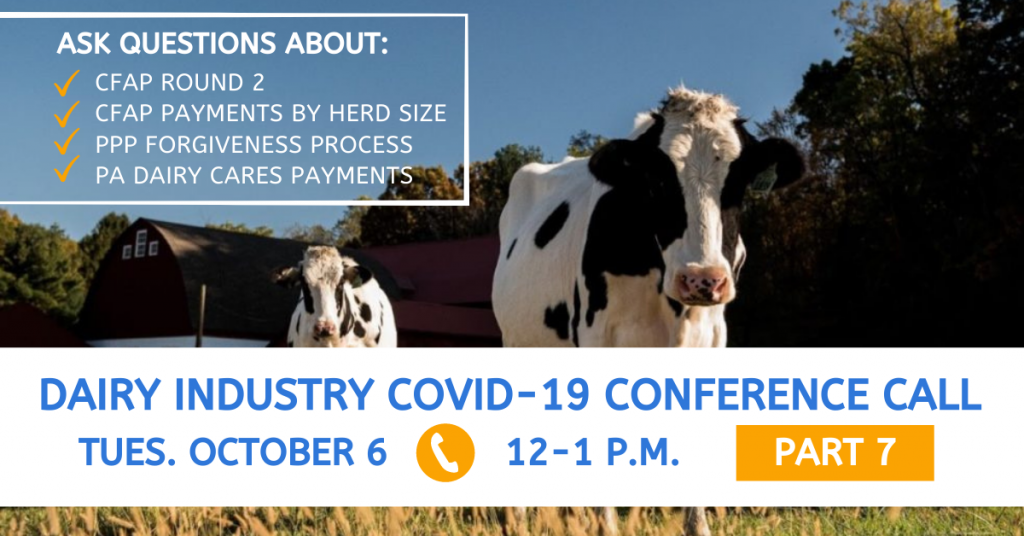
How to Apply for CFAP Round 2 Direct Relief Payments
The USDA recently announced a second round of Coronavirus Food Assistance Program (CFAP2) payments, which will provide additional aid to dairy farmers due to losses generated by the COVID-19 pandemic. FSA began accepting applications on Monday, September 21, with December 11 the deadline to apply. Complete details are available on USDA’S website at farmers.gov/cfap.
Even if you applied for CFAP 1, you must still submit a new application form for CFAP 2 in order to receive a relief payment. You will not need to submit duplicate forms, only the new application. Here’s what you need to know about how to apply.
Eligibility
To be eligible for the dairy-related relief payments in CFAP 2, you must:
- Be producing and selling milk, and be in business, at the time of application
- Be producing milk commercially
- Derive at least 75 percent of your adjusted gross income from farming, ranching or forestry-related activities, or have an average adjusted gross income of less than $900,000 for tax years 2016, 2017 and 2018.
Note: If you have a large dairy and gross more than $900,000 and it is your sole source of income, you are eligible for CFAP 2.
Note: If you did not apply for the original round of CFAP payments, you can still apply for CFAP 2.
Milk production enrolled in risk management programs also qualifies for CFAP 2 payments. Qualifying risk management programs include:
- Livestock Gross Margin
- Dairy Revenue Protection
- Dairy Margin Coverage
Available Support
Milk Production
Dairy producers are eligible for a $1.20 per hundredweight payment on actual milk production from April 1 to August 31, 2020, and estimated production September 1 to December 31, 2020, based on average daily milk production from April to August. 100 percent of the payment will be made once a farm is determined eligible and the payments are approved, meaning there will be no 20% holdback as with earlier assistance.
Cattle
In addition to relief payments for milk production, producers are eligible for cattle inventory payment on bull calves and feeder steers. In general, dairy replacements are not eligible for livestock payments. However, heifers not intended to be replacements are eligible. They must be considered beef animals at the time of application. For example, freemartins and open or pregnant heifers that will be culled prior to calving are all considered eligible inventory.
The beef payment is $55 per head on eligible cattle in inventory on a date selected by the producer between April 16 and the end of August. For livestock inventory to be eligible for CFAP2 payment, they must be subject to price risk, i.e. not contracted.
Crops
Dairy farmers can submit cropping acres for CFAP 2 payments. Depending on crop, producers will be paid according to the price trigger and/or flat rate payment categories
Note: Producers must have an acreage report and Annual Production History (APH) filed with their local FSA office. Producers must also have a signature on an application generated by FSA. The application generated by the online tool cannot pull the acreage information. Farmers that did not report acreage this year will be allowed to retroactively report acreage without being assessed the late reporting fee.
After you receive this information from FSA, you can use the spreadsheet to estimate your payment. But remember, the spreadsheet does not have your APH information or reported acres. So you cannot use the spreadsheet to complete the form itself. If you are reporting acre-based crops, the form must come from your local FSA Office.
Crops must be subject to price risk, i.e. not contracted, to be eligible for CFAP2 payments.
Click here for a full list of eligible commodities and payment rates.
Payment Limitations
The payment limitation per person or entity, for all commodities combined, is $250,000. Entities structured as corporations, limited liability companies, or limited partnerships may qualify for additional payment limits when members actively provide at least 400 hours of personal labor or personal management for the farming operation.
New for CFAP 2, the payment limitation provision is expanded to include trusts and estates. In addition, payment limits will not be reduced based on ownership shares. Previously, each owner’s share of the operation was applied to the payment limitation, not to the overall CFAP payment to which the operation is entitled, but the recent updates solve that problem for both rounds of the program.
How to Apply
Dairy producers can now apply for CFAP 2 assistance. Applications will be accepted through Dec. 11, 2020. Additional information and application forms may be found at farmers.gov/cfap.
All other eligibility forms may be downloaded from farmers.gov/cfap/apply. For existing FSA customers, including those who participated in CFAP 1, many documents are likely already on file but you will still need to submit a CFAP 2 application. Check with your local FSA office to see if any forms need to be updated.
Important note: If dairy producers want to include crops in their application, you will need to work directly with your local FSA Office. See steps for how to do this below. You can call your local FSA Office and ask for an application with the APH and acres already entered in, or you can schedule an appointment. If you are only interested in applying to receive payments for dairy and livestock, you can fill out the application yourself using the tools online. See steps for how to do this below.
Fill Out the Application Directly (For Dairy and Livestock)
- Download the USDA CFAP 2 Application Generator and Payment Calculator. This is an Excel workbook that allows you to input information specific to your dairy operation to determine estimated payments and populate the application form, which you can then print, sign, and submit to the FSA office at your local USDA Service Center.
Note: If you are including acre-based commodities or crops, you must contact your local FSA Office to request the final form to complete. - After downloading the workbook, click “Enable Editing” and “Enable Content” so you can move between the payment calculator and the actual application.
- Make sure you fill out all highlighted parts of the spreadsheet, including the top rows.
Note: Don’t forget the State and County sections.
- When filling in the data parts, you will need your pounds shipped for April 1 – August 31. You can get this information from your settlement checks or from your milk handler.
- You will also need record of the number of bull calves, feeder steers and any heifers intended for the beef market in inventory between April 16 and August 31. You can claim the highest number you had in inventory during that time.
Note: If you did not have any inventory of cattle intended for beef, you can put zeroes in those boxes. - If you intend to claim acre-based crops, including corn, soybeans, wheat and alfalfa, for payment, you will need to work directly with your local FSA Office and request your reported acres for those commodities and your Annual Production History (APH) from the office. Once you have that information, you can enter that in the Acreage-Based Crops section.
Note: Corn, soybeans, alfalfa and other crops grown for feed purposes are eligible to receive a direct payment. This includes corn for silage. - If you don’t have anything else, you can either click on “Print AD-3114” or “Go to AD-3114” to review it and print. As long as the macros are turned on, this works well.
- The farmer needs to sign at the bottom of the second page.
- Visit this link to find your local FSA Office and submit your completed application form.
- The form can be scanned, faxed or mailed to the office. As long as you are already a customer, you don’t need to submit anything else.
Reminder: Farmers should keep a record of their completed application and the documentation used to complete the application for three years in case they get spot-checked.
Reminder for crops: Producers must have an acreage report and Annual Production History (APH) filed with their local FSA office. Producers must also have a signature on an application generated by FSA. The application generated by this online spreadsheet cannot pull the acreage information. After you receive this information from FSA, you can then use the spreadsheet to estimate your payment. But remember, the spreadsheet does not have your APH information or reported acres.
Work with FSA Staff (For Crops)
FSA staff can help you fill out your application. Local staff may ask for:
- Name and address
- Personal information, including your Tax Identification Number
- Farm operating structure
- Adjusted Gross Income compliance certification to ensure eligibility
- Direct deposit information to enable payment
- Some producers may need to file an acreage report
Find the CFAP 2 application (AD-3117) and needed forms: www.farmers.gov/cfap
Find your nearest service center here: www.farmers.gov/service-center-locator
Contact their Customer Call Center: 877-508-8364 Operating hours: 8 AM – 8 PM ET
Frequently Asked Questions
The Center gathered these answers and frequently asked questions from the USDA’s webinar about CFAP 2.
Learn More About CFAP 2 Direct Payments – Join Us for a Dairy Industry Call

Join us for our next dairy industry conference call on Tuesday, October 6 from 12 to 1 p.m. We have invited panelists to share details about the Coronavirus Food Assistance Program (CFAP) Round 2 direct payments for dairy farmers and what payments look like based on herd size. Our panelists will also answer questions about other COVID-19 related issues, including the Payroll Protection Program forgiveness process and the Pennsylvania Dairy CARES Program payment process.
- How to Join:
- Dial (978) 990-5000 via free conference call.
- Enter Access Code 553371, followed by the # sign, when prompted.
- You will automatically be entered into the conference call. You will automatically be muted when you join.
- How to submit questions in advance:
- Text/call 717-585-0766 to send your questions or email zmyers@centerfordairyexcellence.org.
About CFAP
CFAP provides vital financial assistance to producers of agricultural commodities who have suffered a five-percent-or-greater price decline due to COVID-19 and face additional significant marketing costs as a result of lower demand, surplus production, and disruptions to shipping patterns and the orderly marketing of commodities.

